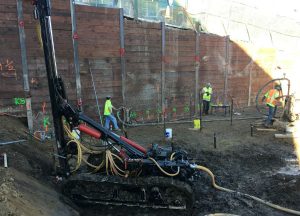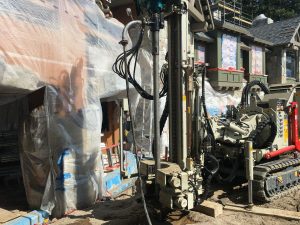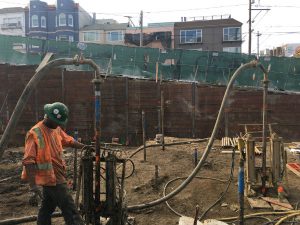About Grouting Technology
 Foundation soil stabilization is a critical, growing specialty in the construction business. As developers are asked to build on less suitable terrain, or accept in-fill work in built-up areas, the task of preparing the foundation and the supporting soil beneath it becomes more challenging. Advances in techniques to properly stabilize less-than-perfect ground soil have kept pace with the challenges, however, and FSS, Inc. is a leader in the field.
Foundation soil stabilization is a critical, growing specialty in the construction business. As developers are asked to build on less suitable terrain, or accept in-fill work in built-up areas, the task of preparing the foundation and the supporting soil beneath it becomes more challenging. Advances in techniques to properly stabilize less-than-perfect ground soil have kept pace with the challenges, however, and FSS, Inc. is a leader in the field.
We craft permeation and compaction grouting solutions that fully stabilize the foundational soil beneath any building’s foundation. Builders no longer must extract unsuitable soil, cart it away and replace it.
 Using binder materials like grout geotechnically converts existing weak soil into a material strong enough to build on, or around, safely. Reinforcing or compacting existing soil in place allows construction to proceed on a shorter schedule and much more cost-effectively.
Using binder materials like grout geotechnically converts existing weak soil into a material strong enough to build on, or around, safely. Reinforcing or compacting existing soil in place allows construction to proceed on a shorter schedule and much more cost-effectively.
This is now an established and highly cost-effective method of construction. Builders now know that any soil found on site can probably be shored up or improved to make it suitable for their planned construction projects.
Foundation soil stabilization also offers significant cost savings over previous site stabilization methods.
Cost
 Leaving soil in place and improving its performance characteristics is much more cost-effective than digging out the unsuitable soil and carting it away to be dumped. We eliminate the cost of dump trucks, landfill taxes and replacement soil or aggregate.
Leaving soil in place and improving its performance characteristics is much more cost-effective than digging out the unsuitable soil and carting it away to be dumped. We eliminate the cost of dump trucks, landfill taxes and replacement soil or aggregate.
The soil stabilization solution reliably results in soil that is stiffer than any existing soil. This allows reduced thickness for designs of foundations and structures or, for roads, subsequent pavement layers.
Time
Soil stabilization takes less time to complete than soil replacement methods, shortening construction schedules.
Waste
No soil is wasted. Our techniques allow builders to avoid the importation of large quantities of replacement materials, like Import Fill Dirt or Type 1 sub base materials, and the export of existing soils.
Environmental Impact
Conventional ground improvement techniques dig out and remove a lot of material that has to be dumped in landfill if it cannot be reused elsewhere. Plus, its removal and replacement requires new material, which had to be extracted and formulated elsewhere. All this demands a lot of trucking to and from a site. We eliminate that environmental impact. The result is lower cost, lower congestion and fewer neighborhood conflicts.
Avoidance of landfill tax
Soil stabilization builds up existing soils to the required strength. Nothing goes to landfill.

